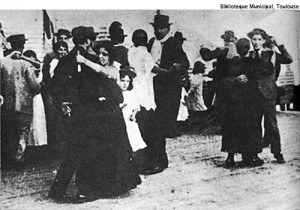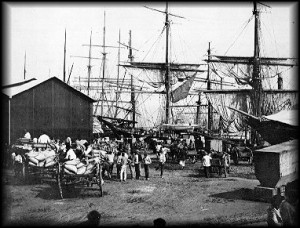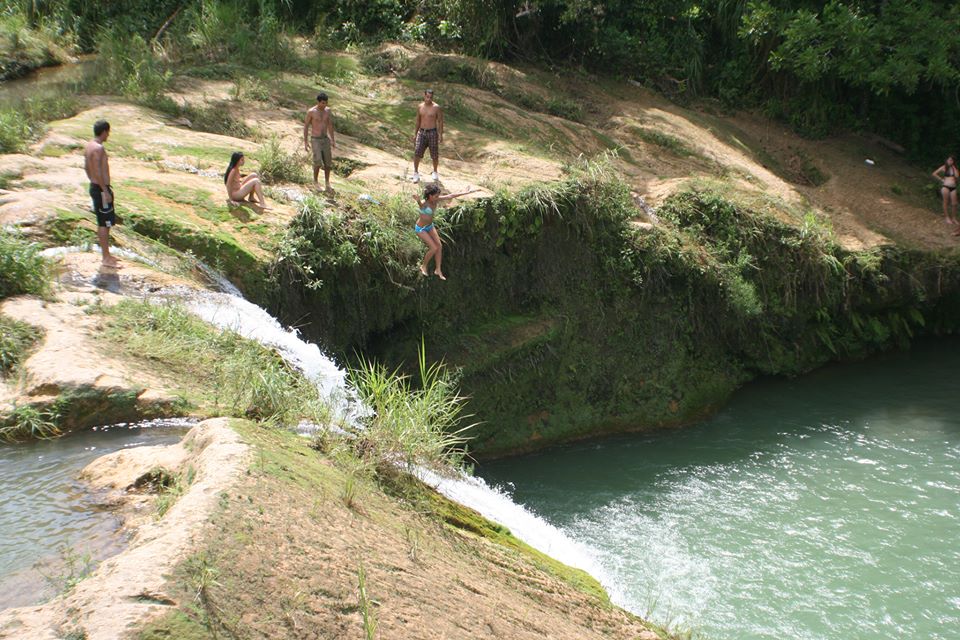![]() Musically, tango is related by genealogy to the Hispano-Cuban habanera and is therefore progeny of trade between the ports of Spanish language in Havana (Cuba) and Buenos Aires (Argentina).
Musically, tango is related by genealogy to the Hispano-Cuban habanera and is therefore progeny of trade between the ports of Spanish language in Havana (Cuba) and Buenos Aires (Argentina).
However, these origins explain little about his birth. Initially, the tango is played by modest groups consisting only of a violin, flute and guitar or even in the absence thereof, the support of a comb made wind instrument with the mediation of a cigarette paper and marking an experienced blower rhythm.
The Argentine milonga and tango uses the habanera rhythm of a dotted quarter followed by three eighth notes, with an accent on the first and third notes.
In 1883 Ventura Lynch, a student of the dances and folklore of the Province of Buenos Aires, Argentina, said the popularity of the milonga, “Milonga is so universal around the city that is a mandatory piece in the whole lower class dances (bailecitos middling), and that is now heard in the guitars, on paper, combs, and traveling musicians with flutes, harps and violins. also been adopted by the organ-grinders, who have arranged to sound like the habanera dance. danced in clubs around low life … [major] markets, and in the dances and wakes purchase drivers, soldiers, compadres and hoodlums.”
http://youtu.be/J6fwPmLVunk
To some extent, the habanera rhythm is maintained in the first tangos, in particular, ‘The Corn’ and that includes “brunette” (1904). As the rhythm steady bass line in the Argentine tango, habanera lasted for a relatively short time. Gradually, the variation observed by Roberts began to predominate, decorated and distributed throughout the texture, remains an essential part of music. Aníbal Troilo, “The trampera” (Woman Trap), written in 1951, uses the habanera observed in Bizet’s Carmen.
Even today, at the beginning of the millennium, a number of Uruguayans and Argentines are still engaged in an ongoing discussion about the paternity of the tango.
The word “tango” appeared long before it would be a dance known as Esteban Pichardo voices in his Dictionary of Cuba (Matanzas, Printing of the Royal Navy, 1836, p. 242), said, Tango: A gathering of black muzzles dance to the drums, as Gobello, was a word that circulated among the countries referred to slave and place, both in Africa and America, where slaves were concentrated.
In Buenos Aires, in early 1800, was called tango to the houses where blacks performed their dances.
LA HABANERA GOES TO RIO LA PLATA.
Along with the visiting zarzuelas companies to the Rio de la Plata ports reach by the Spanish marine squads, bringing the Cuban musical genre popular at that time, the habanera. By 1865 the city’s theaters have become popular for his paintings incorporating art and music under the name American tango. The contribution of the Hispanic-Cuban habanera the tango is equally important that the African contribution, next to the milonga and candombe the same ancestry Oche Califa.
The tango, a bond sensitive and sentimental, like the bolero and other musical genres born in the brothel areas or marginal environments of the time. The first tangos themselves date from the beginning of 1880, his lyrics are obscene and titles leave no doubt that the first known tango was ‘Give me the beat’: the can was a metal object that the “madam” of a brothel gave to “the girls” for each client to collect their share of the “pimp”, I said give me the can. Other titles such as ‘Two without removing’, ‘Such a hit it does not fit’, ‘Seven Inch’ and even ‘the corn’, but really means that ear of corn, in the figurative sense is equivalent to the Castilian vulgar “pussy” or “pussy” that reveal the origin of these early tangos.
By the early twentieth century are the great creators of tango as the Uruguayan Enrique Saborido, Rosendo Mendizabal, Angel Villoldo, Manuel Eduardo Campoamor and Arolas, among others, who with his compositions created the foundations of the genre, is when you hear ‘The Entre ‘,’ the brunette ‘and’ The porteñito ‘, this was the time of the first revolution of the tango and the emergence of the “Old Guard” River Plate.
In 1907 he produced the internationalization of the tango when brought to Paris by the Uruguayan Enrique Alfredo Gobbi and Saborido. In France gender is sheer madness and thence expands throughout Europe and North America. By 1916 a tango by Samuel Castriota entitled Lita, along with the letter of the composer Pascual Contrusi, give birth to Mi noche triste, a tango-song popularized in 1917’s River Plate a humble singer called Carlos Gardel, the most famous interpreter of tango of all time and become a legend after his death in a tragic plane crash in Colombia in 1935.
From the first tango and revolution through the Old Guard, the tango-song orchestral tango Julio de Caro that joins the River Plate music resources of musical technique, the famous letters of Celedonio Esteban Flores embody same evolution of society and successfully added gender slang, the slang, and make it popular, Enrique Santos Discípolo, Catulo Castillo, Eduardo Rivero, Alberto Castillo, Piazzola, Pugliese, Uruguayan Canaro, Roberto Goyeneche and many others we make it impossible to concentrate on so few lines, his triumphs; ‘El día que me quieras, ‘Madame Ivonne’, ‘Garúa’, ‘Por una cabeza, ‘Mano a mano’ y ‘Caminito’, del argentino Juan de Dios Filiberto, all, along with the stories of the reconstructed Old Store today in the neighborhood of San Telmo, Buenos Aires, and the Café La Giralda in Montevideo, Uruguay, where it premiered ‘The cumparcita’, the “hymn of the tangos” memories are not only more than a century of tango are reminiscent of a genre that will live and endure forever as a heritage of America.
Agencies/Wiki/LaHabaneraStory/InternetPhotos/youtube/TheCubanHistory.com
THE CUBAN HISTORY, HOLLYWOOD.
Arnoldo Varona, Editor.
LA HABANERA SE VA A LA ARGENTINA. El Tango, Herencia de Nuestra América. VIDEO.
![]() Musicalmente, tango se relaciona por la genealogía con la habanera Hispano-Cubano y por lo tanto progenie del comercio entre los puertos de lengua española en la Habana (Cuba) y Buenos Aires (Argentina).
Musicalmente, tango se relaciona por la genealogía con la habanera Hispano-Cubano y por lo tanto progenie del comercio entre los puertos de lengua española en la Habana (Cuba) y Buenos Aires (Argentina).
Sin embargo, estos orígenes explican poco acerca de su nacimiento. Inicialmente, el tango es interpretado por modestos grupos que consta sólo de un violín, flauta y guitarra o incluso en la ausencia, el apoyo un peine hecho de instrumento de viento con la mediación de un papel de fumar y marcando un ritmo de soplador experimentado.
El argentino milonga y el tango utiliza el ritmo de habanera de un cuarto de puntos seguido por tres corcheas con un acento en las notas del primeras y terceros.
En 1883 Ventura Lynch, un estudiante de las danzas y el folclore de la provincia de Buenos Aires, Argentina, la popularidad de la milonga, “Milonga es tan universal alrededor de la ciudad que es una pieza obligatoria en las danzas de toda la clase inferior (bailecitos piratean), y que ahora se escucha en las guitarras, en papel, peines y música itinerante con flautas, arpas y violines. también ha adoptado el órgano-Rectificadoras que han dispuesto a sonar como la danza habanera. bailaba en clubs alrededor de vida bajo… [principales] mercados y en los bailes y estelas compra conductores, soldados, compadres y matones.”
http://youtu.be/J6fwPmLVunk
En cierta medida, el ritmo de la habanera se mantiene en los primeros tangos, en particular, ‘El maíz’ y que incluye “morena” (1904). Como el ritmo constante línea de bajo en la Argentina tango, habanera duró un tiempo relativamente corto. Poco a poco, la variación observada por Roberts comenzó a predominar, decorado y distribuido a través de la textura, sigue siendo una parte esencial de la música. Aníbal Troilo, “La trampera” (mujer trampa), escrito en 1951, usos observada la habanera de Carmen de Bizet.
Aún hoy, a principios del Milenio, un número de uruguayos y argentinos todavía participan en una discusión permanente sobre la paternidad del tango.
La palabra “tango” apareció mucha antes de que sea una danza conocida como voces de Esteban Pichardo en su Diccionario de Cuba (Matanzas, impresión de la Real Marina, 1836, p. 242), dijo: el Tango: un encuentro de danza de negros bozales a los tambores, como Gobello, era una palabra que circula entre los países mencionados para esclavos y lugar, tanto en África y América , donde se concentraron esclavos.
En Buenos Aires, en principios de 1800, fue llamado tango a las casas donde los negros realizaban sus bailes.
LA HABANERA SE VA AL RÍO LA PLATA.
Junto con las zarzuelas visitantes empresas a los puertos del río de la Plata alcanzan por los escuadrones de Marina españolas, llevar el género musical cubano popular en aquel momento, la habanera. Por 1865 teatros de la ciudad se han convertido en populares por sus pinturas incorpora el arte y la música en el tango americano de nombre. La contribución de la habanera hispano-cubana el tango es igual de importante que la contribución africana, junto a la milonga y el candombe la misma ascendencia Oche Califa.
El tango, un vínculo sensible y sentimental, como el bolero y otros géneros musicales nacidos en el burdel áreas o ambientes marginales de la época. Los primeros tangos se datan de principios de 1880, sus letras son obscenas y títulos no dejan duda alguna que el primer tango conocido era ‘Dame el ritmo’: el poder era un objeto de metal que la “señora” de un burdel le dio a “las chicas” para que cada cliente recoger su parte del “pimp”, dijo Dame la lata. Otros títulos como “Dos sin sacar”, ‘Tanto éxito hace no encajan’, ‘Siete pulgadas’ y hasta ‘el maíz’, pero realmente significa que mazorca de maíz, en el sentido figurado es equivalente al castellano vulgar “coño” o “coño” que revelan el origen de estos primeros tangos.
A principios del siglo XX son los grandes creadores del tango como el uruguayo Enrique Saborido, Rosendo Mendizabal, Angel Villoldo, Manuel Eduardo Campoamor y Arolas, entre otros, que con sus composiciones ha creado las bases del género, cuando escuches ‘Entre la’,’ la morena ‘ y ‘El porteñito’, este fue el momento de la primera revolución del tango y la aparición de la “Vieja guardia” río de la plata.
En 1907 produjo la internacionalización del tango cuando trajo a la Paris por el uruguayo Enrique Alfredo Gobbi y Saborido. En Francia el género es pura locura y desde allí se expande por toda Europa y América del norte. Por 1916 un tango de Samuel Castriota había titulado Lita, junto con la letra del compositor Pascual Contrusi, dar a luz a Mi noche triste, una canción de tango popularizado en River Plate de 1917 un humilde cantor llamado Carlos Gardel, el más famoso intérprete del tango de todos los tiempos y conviértete en una leyenda tras su muerte en un trágico accidente en Colombia en 1935.
Desde el primer tango y revolución a través de la vieja guardia, la canción de tango orquesta Julio de Caro que une los recursos de la música de River Plate de técnica musical de tango, las famosas Letras de Celedonio Esteban Flores encarnan la misma evolución de la sociedad y con éxito añadido argot del género, la jerga y hacen popular, Enrique Santos Discípolo, Catulo Castillo, Eduardo Rivero, Alberto Castillo, Piazzolla, Pugliese , Uruguayo Canaro, Roberto Goyeneche y muchos otros que hacen imposible concentrarse en tan pocas líneas, sus triunfos; ‘ El día que me quieras, ‘Madame Ivonne’, ‘Garúa’, ‘ Por una cabeza, ‘Mano a mano’ y ‘Caminito’, del argentino Juan de Dios Filiberto, de todo, junto con las historias de la tienda antigua reconstruida hoy en el barrio de San Telmo, Buenos Aires y la Café La Giralda de Montevideo, Uruguay, donde se estrenó “La cumparcita”, el “Himno de los tangos” los recuerdos no es sólo más de un siglo de tango son una reminiscencia de un género que vivir y soportar para siempre como un patrimonio de América.
Agencies/Wiki/LaHabaneraStory/InternetPhotos/youtube/TheCubanHistory.com
LA HISTORIA DE CUBA, HOLLYWOOD.
Arnoldo Varona, Editor.





